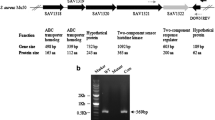Abstract
Sixteen pairs of two-component regulatory systems are identified in the genome of Staphylococcus epidermidis ATCC12228 strain, which is newly sequenced by our laboratory for Medical Molecular Virology and Chinese National Human Genome Center at Shanghai, by using bioinformatics analysis. Comparative analysis of the twocomponent regulatory systems in S. epidermidis and that of S. aureus and Bacillus subtilis shows that these systems may regulate some important biological functions, e.g. growth, biofilm formation, and expression of virulence factors in S. epidermidis. Two conserved domains, i.e. HATPase c and REC domains, are found in all 16 pairs of two-component proteins. Homologous modelling analysis indicates that there are 4 similar HATPase c domain structures of histidine kinases and 13 similar REC domain structures of response regulators, and there is one AMP-PNP binding pocket in the HATPase c domain and three active aspartate residues in the REC domain. Preliminary experiment reveals that the bioinformatics analysis of the conserved domain structures in the two-component regulatory systems in S. epidermidis may provide useful information for discovery of potential drug target.
Similar content being viewed by others
References
Rupp, M. E., Archer, G. L., Coagulase-negative staphylococci: Pathogens associated with medical progress, Clin. Infect. Dis., 1994, 19:231–243.
Thylefors, J. D., Harbarth, S., Pittet, D., Increasing bacteremia due to coagulase-negative staphylococci: fiction or reality? Infect Control Hosp Epidemiol., 1998, 19: 581–589.
Zhang, X. Q., Ren, S. X., Li, H. L. et al., Genome-based analysis of virulence genes in a non-biofilm-forming Staphylococcus epidermidis strain (ATCC 12228), Mol. Microbiol., 2003, 49: 1577–1593.
Stephenson, K., Hoch, J. A., Two-component and phosphorelay signal-transduction systems as therapeutic targets, Curr. Opin. Pharmacol., 2002, 2: 507–512.
Schwede, T., Kopp, J., Guex, N. et al., SWISS-MODEL: An automated protein homology-modelling server, Nucleic Acids Res., 2003, 31:3381–3385.
Guex, N., Peitsch, M. C., SWISS-MODEL and the Swiss-PdbViewer: An environment for comparative protein modelling, Electrophoresis, 1997, 18: 2714–2723.
Peitsch, M. C., Protein modelling by E-mail, Bio/Technology, 1995, 13: 658–660.
Throup, J. P., Koretke, K. K., Bryant, A. P. et al., A genomic analysis of two-component signal transduction in Streptococcus pneumoniae, Mol. Microbiol., 2000, 35: 566–576.
Lange, R., Wagner, C., de Saizieu, A. et al., Domain organization and molecular characterization of 13 two-component systems identified by genome sequencing of Streptococcus pneumoniae, Gene, 1999, 237: 223–234.
Vuong, C., Gerke, C., Somerville, G. A. et al., Quorum-sensing control of biofilm factors in Staphylococcus epidermidis, J. Infect Dis., 2003, 188: 706–718.
Fabret, C., Hoch, J. A., A two-component signal transduction system essential for growth of Bacillus subtilis: Implications for antiinfective therapy, J. Bacteriol., 1998, 180: 6375–6383.
Giraudo, A. T., Calzolari, A., Cataldi, A. A. et al., The sae locus of Staphylococcus aureus encodes a two-component regulatory system, FEMS Microbiol. Lett., 1999, 177: 15–22.
Fournier, B., Hooper, D. C., Anew two-component regulatory system involved in adhesion, autolysis, and extracellular proteolytic activity of Staphylococcus aureus, J. Bacteriol., 2000, 182: 3955–3964.
Yarwood, J. M., McCormick, J. K., Schlievert, P. M., Identification of a novel two-component regulatory system that acts in global regulation of virulence factors of Staphylococcus aureus, J. Bacteriol., 2001, 183: 1113–1123.
Pragai, Z., Eschevins, C., Bron, S. et al., Bacillus subtilis NhaC, an Na+/H+ antiporter, influences expression of the phoPR operon and production of alkaline phosphatases, J. Bacteriol., 2001, 183: 2505–2515.
Recsei, P., Kreiswirth, B., O’ Reilly, M. et al., Regulation of exo protein gene expression in Staphylococcus aureus by agar, Mol. Gen. Genet, 1986, 202: 58–61.
Brunskill, E. W., Bayles, K. W., Identification of LytSR-regulated genes from Staphylococcus aureus, J. Bacteriol., 1996, 178: 5810–5812.
Dartois, V., Debarbouille, M., Kunst, F. et al., Characterization of a novel member of the DegS-DegU regulon affected by salt stress in Bacillus subtilis, J. Bacteriol., 1998, 180: 1855–1861.
Tanaka, T., Saha, S. K., Tomomori, C. et al., NMR structure of the histidine kinase domain of the E. coli osmosensor EnvZ, Nature, 1998, 396: 88–92.
Cho, H. S., Lee, S. Y., Yan, D. et al., NMR structure of activated Che Y, J. Mol. Biol., 2000, 297: 543–551.
Stephenson, K., Hoch, J. A., Virulence and antibiotic resistanceassociated two-component signal transduction systems of Gram-positive pathogenic bacteria as targets for antimicrobial therapy, Pharmacol. Ther, 2002, 93: 293–305.
Roychoudhury, S., Zielinski, N. A., Ninfa, A. J. et al., Inhibitors of two-component signal transduction systems: Inhibition of alginate gene activation in Pseudomonas aeruginosa, Proc. Natl. Acad. Sci. USA, 1993, 90: 965–969.
Stephenson, K., Yamaguchi, Y., Hoch, J. A., The mechanism of action of inhibitors of bacterial two-component signal transduction systems, J. Biol. Chem., 2000, 275: 38900–38904.
Hilliard, J. J., Goldschmidt, R. M., Licata, L. et al., Multiple mechanisms of action for inhibitors of histidine protein kinases from bacterial two-component systems, Antimicrob Agents Chemother, 1999, 43: 1693–1699.
Author information
Authors and Affiliations
Corresponding authors
About this article
Cite this article
Zhiqiang, Q., Yang, Z., Jian, Z. et al. Bioinformatics analysis of two-component regulatory systems in Staphylococcus epidermidis . Chin.Sci.Bull. 49, 1267–1271 (2004). https://doi.org/10.1360/03wc0384
Received:
Accepted:
Published:
Issue Date:
DOI: https://doi.org/10.1360/03wc0384



